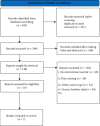Efficacy of Traditional Chinese Medicine Combined with Chemotherapy in the Treatment of Gastric Cancer: A Meta-analysis
- PMID: 35966237
- PMCID: PMC9371868
- DOI: 10.1155/2022/8497084
Efficacy of Traditional Chinese Medicine Combined with Chemotherapy in the Treatment of Gastric Cancer: A Meta-analysis
Abstract
Objective: Meta-analysis was conducted to explore the effects of CM combined with chemotherapy on the effective rate and survival rate of gastric cancer patients.
Methods: Literature retrieval was performed in PubMed, MEDLINE, Embase, CENTRAL, and CNKI databases. The subject of the literature was to compare the efficacy of CM combined with chemotherapy and chemotherapy alone in patients with gastric cancer. According to the Cochrane manual, the risk of bias was assessed for inclusion in randomized controlled trials. The chi-square test was used for the heterogeneity test. Subgroup analysis and sensitivity analysis were used to explore the causes of heterogeneity. Funnel chart and Egger's test were used to assess publication bias.
Results: This study included 761 patients with gastric cancer from 10 literatures. The effective rate of chemotherapy in the CM combined group was higher than that in the chemotherapy alone group (odds ratio (OR) = 1.96, 95% confidence interval (CI) (1.39, 2.78), Z = 3.81, P = 0.0001), and there was no heterogeneity among studies (chi2 = 5.68, P = 0.68, I 2 = 0%). There was no significant publication bias among all studies (P > 0.05). The one-year survival rate in the CM combined group was higher than that in the chemotherapy alone group (OR = 3.25, 95% CI (1.90, 5.54), Z = 4.32, P < 0.0001). There was no heterogeneity among studies (chi2 = 1.04, P = 0.79, I 2 = 0%) and no significant publication bias among studies (P > 0.05). The 3-year survival rate of gastric cancer patients in the traditional Chinese medicine combination group was higher than that in the chemotherapy alone group (OR = 1.71, 95% CI (1.06, 2.78), Z = 2.18, P = 0.03). There was no heterogeneity among studies (chi2 = 2.18, P = 0.54, I 2 = 0%), and there was no significant publication bias (P > 0.05). The incidence of nausea and vomiting after chemotherapy in gastric cancer patients in the Chinese medicine combination group was lower than that in the chemotherapy alone group (OR = 0.47, 95% CI (0.34, 0.64), Z = 4.80, P < 0.00001). There was no heterogeneity among studies (chi2 = 8.57, P = 0.48, I 2 = 0%), and there was no significant publication bias (P > 0.05).
Conclusion: CM combined with chemotherapy can improve the effective rate and survival rate of gastric cancer and reduce the incidence of nausea and vomiting after chemotherapy. We recommend a large sample size, multicenter combined randomized controlled trial for validation.
Copyright © 2022 Wenxin Zhang et al.
Conflict of interest statement
The authors have no conflicts of interest to declare.
Figures









Similar articles
-
[Meta analysis of whether cytoreductive surgery combined with hyperthermic intraperitoneal chemotherapy can improve survival in patients with colorectal cancer peritoneal metastasis].Zhonghua Wei Chang Wai Ke Za Zhi. 2021 Mar 25;24(3):256-263. doi: 10.3760/cma.j.cn.441530-20201111-00604. Zhonghua Wei Chang Wai Ke Za Zhi. 2021. PMID: 34645170 Chinese.
-
Meta-Analysis of Efficacy and Safety of Karelizumab Combined with Apatinib in the Treatment of Advanced Gastric Cancer.Dis Markers. 2022 Sep 22;2022:6971717. doi: 10.1155/2022/6971717. eCollection 2022. Dis Markers. 2022. PMID: 36193493 Free PMC article. Review.
-
Intravenous chemotherapy for resected gastric cancer: meta-analysis of randomized controlled trials.World J Gastroenterol. 2002 Dec;8(6):1023-8. doi: 10.3748/wjg.v8.i6.1023. World J Gastroenterol. 2002. PMID: 12439918 Free PMC article.
-
Effect of Different General Anesthesia Methods on the Prognosis of Patients with Breast Cancer after Resection: A Systematic Review and Meta-analysis.Comput Math Methods Med. 2022 Jun 28;2022:6846079. doi: 10.1155/2022/6846079. eCollection 2022. Comput Math Methods Med. 2022. PMID: 35799639 Free PMC article.
-
Efficacy of traditional Chinese Medicine combined with chemotherapy in patients with non-small cell lung cancer (NSCLC): a meta-analysis of randomized clinical trials.Support Care Cancer. 2020 Aug;28(8):3571-3579. doi: 10.1007/s00520-020-05433-w. Epub 2020 Apr 7. Support Care Cancer. 2020. PMID: 32266566
Cited by
-
Jian Yun Qing Hua Decoction inhibits malignant behaviors of gastric carcinoma cells via COL12A1 mediated ferroptosis signal pathway.Chin Med. 2023 Sep 12;18(1):118. doi: 10.1186/s13020-023-00799-5. Chin Med. 2023. PMID: 37700383 Free PMC article.
-
Inhibition of EREG/ErbB/ERK by Astragaloside IV reversed taxol-resistance of non-small cell lung cancer through attenuation of stemness via TGFβ and Hedgehog signal pathway.Cell Oncol (Dordr). 2024 Dec;47(6):2201-2215. doi: 10.1007/s13402-024-00999-7. Epub 2024 Oct 7. Cell Oncol (Dordr). 2024. PMID: 39373858
-
TCM Prescription Generation via Knowledge Source Guidance Network Combined with Herbal Candidate Mechanism.Comput Math Methods Med. 2023 Jan 3;2023:3301605. doi: 10.1155/2023/3301605. eCollection 2023. Comput Math Methods Med. 2023. PMID: 36643583 Free PMC article.
-
Molecular targets and mechanisms of traditional Chinese medicine combined with chemotherapy for gastric cancer: a meta-analysis and multi-omics approach.Ann Med. 2025 Dec;57(1):2494671. doi: 10.1080/07853890.2025.2494671. Epub 2025 May 3. Ann Med. 2025. PMID: 40317214 Free PMC article.
-
Research progress of integrated traditional Chinese and Western medicine in the treatment of advanced gastric cancer.World J Gastrointest Oncol. 2023 Jan 15;15(1):69-75. doi: 10.4251/wjgo.v15.i1.69. World J Gastrointest Oncol. 2023. PMID: 36684044 Free PMC article. Review.
References
Publication types
MeSH terms
LinkOut - more resources
Full Text Sources
Medical

